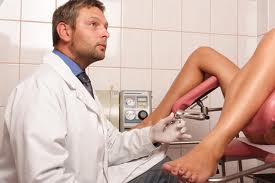
In the next few years we'll probably find that women will be actually looking forward to spreading their legs for that all-important PAP TEST. A new study suggests that the ''embarassing'' Pap Test, which has prevented countless deaths from cervical cancer, may now help in detecting cancers of the uterus and ovaries as well.
For the first time, researchers have found genetic material from uterine or ovarian cancers in Pap smears, meaning that it should become possible to detect three diseases with just one routine test. The research is early and needing a few years to refine before being a part in regular medical practice. The women studied were already known to have cancer and while the Pap Test found 100% of uterine cancers, it detected only 45% of the ovarian cancers. On the other hand, even a 45% detection rate would be better than the status quo the exists in ovarian cancer, particularly if the detection extends to early stages. The disease is usually advanced by the time it is found and survival rates are poor. Uterine cancer has a better prognosis. Improved tests are urgently needed.
These innovative applications of the Pap Test are part of a new era in which advances in genetics are being applied to the detection of a wide variety of cancers and precancerous conditions. Scientists are learning to find minute bits of mutant DNA in tissue samples or bodily fluids that may signal the presence of hidden or incipient cancers. Ideally, the new techniques would find the abnormalities early enough to cure the disease or even prevent it entirely. Bit it is too soon to tell.
''Is this the harbinger of things to come? I would answer Yes,'' said Dr Bert Vogelstein, director of the Ludwig Center of Cancer Genetics and Therapeutics at John Hopkins University, and a senior author of a report on the Pap study published in the Journal of Science & Translational Medicine. He said genomes of more than 50 types of tumors had been sequenced, and researchers are taking advantage of the new information. Similar studies are under way or are being considered to look for mutant DNA in blood, stool, urine and sputum, both to detect cancer and also to monitor the response to treatment in people known to have the disease.
Dr Christopher P. Crum, a professor at Harvard Medical School who was not involved in the research called the study ''a great proof of principle. Any whisper of hope to women who suffer from endometrial or ovarian cancer would be most welcome.'' Dr Vogelstein and his team hit on the idea to try DNA testing Pap smears for cancer. They theorized that cells or DNA shed from cancers of the ovaries and uterine lining (endometrium) might reach the cervix and turn up in Pap smears. The team picked common mutations found in these cancers, and looked for them in tumor samples. All the cancers had one or more of the common mutations. Using a control sample of 15 healthy women, the test found no mutations -- meaning no false-positive results.
Dr Luis A. Diaz, the other senior author of the report stated, ''probably one of the most exciting features of this approach is that we wanted a test that would seamlessly integrate with routine medical practice that could be utilized with the same test that women get every day all over the world, the Pap smear.'' But, he added; ''We can't say it's ready for prime time. Like all good science, it needs to be validated a while longer.'' He and other members of the team are working hard to improve the detection rate for ovarian cancer by looking for more mutations by changing their technique slightly.
The Way I See It....the technique also needs to be tested in much larger groups of women, including healthy ones, to find out whether it works, particularly at finding cancers early enough to improve survival. And the studies must also find out whether it generates false positive results. This is a step toward a screening test that at first blush appears very effective at detecting such nasty cancers in women. It's very promising, in part because it is based on finding mutations, it tells you not just that cancer is there but which mutation is there so treatment could be more specific. Now women will have a lot to smile about.

No comments:
Post a Comment